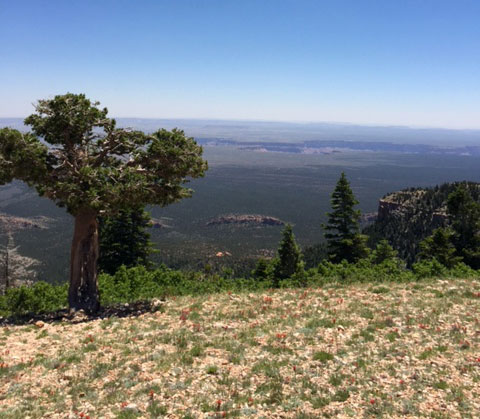Here's a Brune family road trip tip: Good things often wait at the end of dirt roads. In this case, after a bumpy 13-mile drive on national forest roads, we reached the highest point on Arizona's Kaibab Plateau, a spot called Marble Viewpoint.
Here's what we saw: To the north, were the Vermilion Cliffs and Paria Canyon. To the northeast, divided from the Vermilion Cliffs by the Colorado River and Marble Canyon*, were the Echo Cliffs. Due east was the Grand Canyon. And directly below us lay House Rock Valley. From where we stood, it was like a symphony of sky, clouds, and what the poet Gary Snyder described as "vast mazy avenues of stone." Breathtaking.

And here's what we didn't see: Dotted lines to tell us which parts of the lands stretching before us were protected as a national park or monument -- and which were at risk from uranium mining and old-growth forest logging. And that's exactly why we need a comprehensive Grand Canyon Watershed National Monument.
All of these magnificent public lands are held dear by Arizonans, Native American tribes, and Americans across the country. They provide water to the Colorado River and clean drinking water for millions of people in Arizona, Nevada, and California. They support countless opportunities for outdoor recreation and spiritual renewal, and they draw people from around the world. In the process, they also generate millions of dollars each year for the local economy while supporting thousands of jobs. Clearly, these lands are valuable, but protecting them is also a matter of taking responsibility.
When President Teddy Roosevelt first protected the lands that (over the objections of mining interests) later became Grand Canyon National Park, he stood at the canyon's rim and said: "We have gotten past the state, my fellow-citizens, when are to be pardoned if we treat any part of our country as something to be skinned for two or three years for the use of the present generation, whether it is the forest, the water, the scenery. Whatever it is, handle it so that your children's children will get the benefit of it."
Unfortunately, there are still people who are only too happy to "skin" these public lands for profit. What local people are most concerned about is a resurgence of interest in uranium mining. Despite strong opposition from Native American tribes, scientists, businesses, sportsmen, local governments, and conservation groups, there have been repeated attempts to roll back the temporary moratorium that currently protects the watershed from new uranium mining.
Think about it: Would you like to see trucks rumbling through your community trailing clouds of carcinogenic radioactive dust? And in an American West where water is an ever more precious resource, do we really want to risk contaminating even a single drop for the sake of a uranium mine?
Such concerns are a big reason why a recent poll found that 73 percent of Arizonans support designating the public lands around Grand Canyon as a national monument. But there's another reason: The people here love and value these lands. And, as Teddy Roosevelt said, they want these lands to be there for their children's children, too.
We spent much of the last few days of our trip exploring the lands around the Grand Canyon, but two trips stood out for me. On Saturday, I joined Havasupai spiritual leaders and about 10 Havasupai teenagers for a healing hike up to the top of Red Butte (which is in the southern part of the proposed national monument). Red Butte is a sacred site for a number of tribes in the Southwest. It is also within two miles of the Canyon Mine, an active uranium mine that has already contaminated water and plants in the area with radiation. The irony that this sacred place of healing is itself in danger of being sickened was not lost on us.

Then, on Sunday, Father's Day, I spent a few hours hiking in the Grand Canyon itself with my oldest daughter, Olivia. (My wife, son, and younger daughter were on an emergency diaper-resupply mission.) More than a hundred years after President Roosevelt protected the Grand Canyon, we were happy to reap the benefit of his foresight. Now, it's time for President Obama to finish the job and grant the same protection to the entire Grand Canyon Watershed. That way, the next time I or you stand on top of Marble Viewpoint, we'll know that everything we see will be there for future generations as well.
*A historical footnote: Marble Canyon was the site of a fierce fight led by David Brower and activist Martin Litton in 1966 to prevent the construction of a dam. That campaign included ads in the New York Times that helped galvanize an energized national environmental movment that culminated in Earth Day 1970.